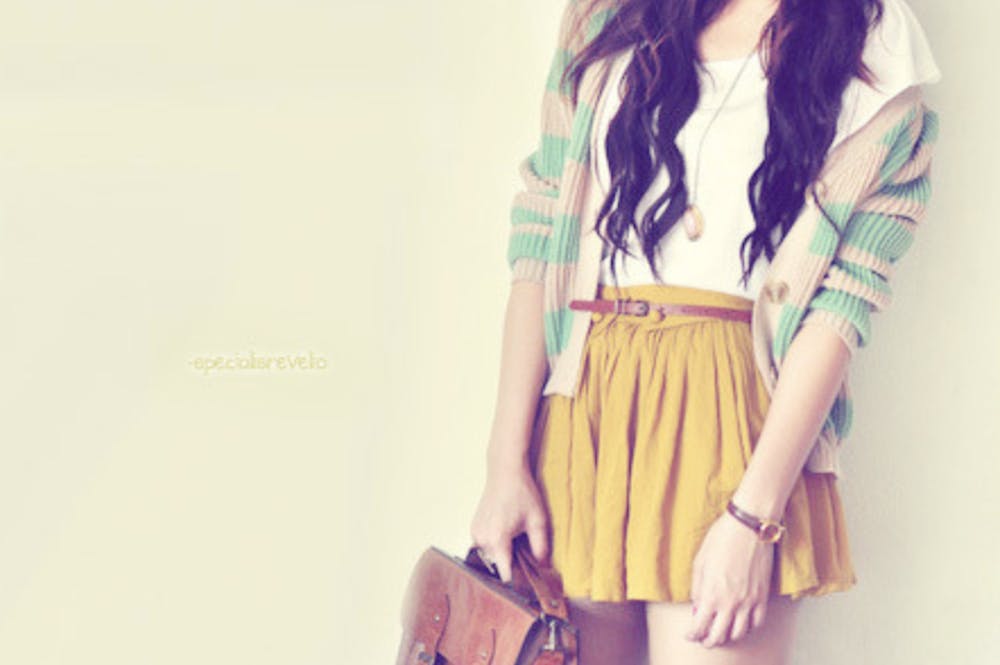Fashion is moving toward something that no one wanted: the return of 2010s fashion. The 20-year rule dictates that it takes 20 years for a trend to become fashionable again. Yet, thanks to TikTok and Instagram’s microtrends, fashion is moving at a much more rapid rate.
In terms of production of fashion, microtrends are much more environmentally threatening. Styles come into fashion and within a few months, they’re outdated. With exploitative labor practices, massive carbon emissions, and so much else, it is a cycle that we cannot afford to continue. And, with the recent boom in Y2K fashion, it seems like the natural next step will be the 2010s.
Beyond the questions of sustainability, new trend cycles are pushing fashion dangerously back to 2010. To start, let’s think back to the 2010s.
Galaxy tights, wedge sneakers, handlebar mustache everything, high-low skirts, chevron prints, gladiator sandals, cracked nail polish and flower crowns. If we could place the 2010s in a lifetime, it is the quintessential middle school period of fashion: confused, vaguely traumatized and all-around disorder.
Some of these trends stemmed from the historical moment. Like Princess Diana, the additions of Kate Middleton and Meghan Markle to the royal family have definitely had a fashion impact. Middleton’s style of high-waisted trousers, conservative dresses, and heels drew many adherents. Similarly, Markle’s choice of smaller designers and brands like Aritzia and Reformation increased their relevance for many consumers. Both, as WWD writes, seem to have “the magic touch when it comes to influencing consumer purchases.” The outfits they wore to the royal engagements sold out in minutes after the photos were released.
Additionally, we have seen the increased role of Generation Z Internet culture in the fashion world, inspiring the rise of trends like the VSCO girl and the E-Boy. This late 2010s boost came through the emergence of TikTok and continues to have powerful influence on the consumer market.
Thankfully, when trends reemerge, they tend to get some modern updates. Take Paco Rabamme’s show for Fall 2022. We see a reinvention of the bubble skirts and peplum tops. Or even look at the Maison Rabih Kayrouz show, particularly look 4. Again, a modern take on the peplum. In Attico spring collection, we see high-low pieces, metallic sequins, and fringe – all clear reminders of the 2010s era of fashion.
Even with those modern takes, we shouldn’t bring everything back from the 2010s, particularly its increasingly prominent cultural appropriation within the fashion industry. Some examples include the 2010 Victoria's Secret fashion show titled “Wild Things,” the 2012 lawsuit against Urban Outfitters for the use of “Navajo” whenever marketing “tribal” prints and Valentino’s spring/summer 2016 show. As London-based international fashion director Zadrian Smith writes on representation and appropriation, “If the people at these tables only come from one culture, they can’t see how appropriating from another culture could be considered as problematic.”
This is not to say that cultural appropriation was new to the 2010s. Its roots extend as far back as the 17th century. English and French aristocracies would wear three-piece suits clearly drawn from traditional garb in Islamic countries. But, certainly, in the 2010s, such appropriation grew to a place of normality within the fashion industry. Only recently, with greater pushback, does the fashion industry seem to be taking some accountability for their role in the dilution and exploitation of global cultures.
One of the many brands that may just be left in the 2010s is Victoria’s Secret. Following Jeffrey Epstein investigations, news came out of L Brand CEO Lex Warner’s involvement as a client of Epstein. And though Victoria’s Secret has made attempts to be more inclusive, notably through the hiring of trans model Valentina Sampaio, sales have fallen from $8 billion to $7.4 billion in 2019.
Unfortunately not all of these abuses seem to be escapable. Dov Charney, who founded the famous brand American Apparel, was charged with sexual harassment and fired in 2014. Regardless of the charges, Charney went on to create the now famous brand, Los Angeles Apparel, generating $32.20 million in sales. So, while we seem to move forward in some areas of fashion, ever-growing pockets of exploitation and abuse continue.
As WWD writes, “Fashion is a top-down system.” When luxury brands market pieces that exploit and abuse cultural traditions and values, it translates into the commercial market. And, when abusers run the businesses, it translates into labor practices, the market, and the overall ethical impact of the company. Can we learn from the lessons of the 2010s? I certainly hope so.
Get The Chronicle straight to your inbox
Signup for our weekly newsletter. Cancel at any time.

